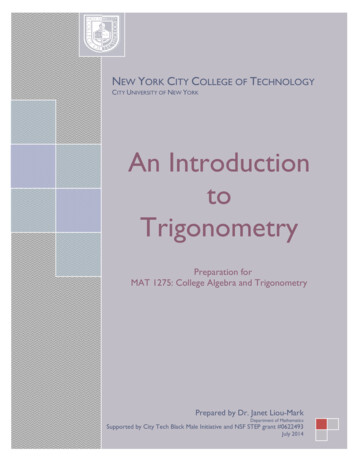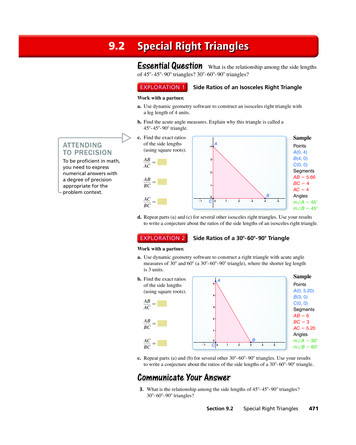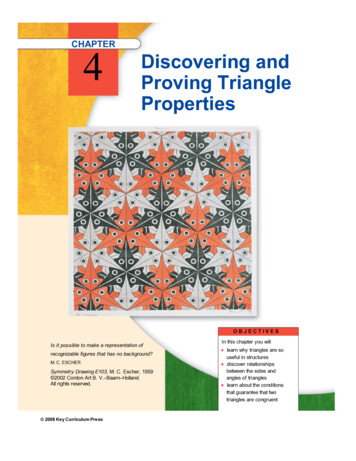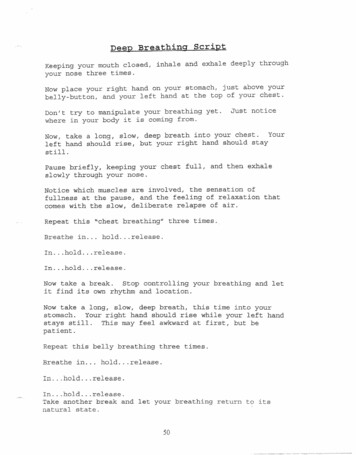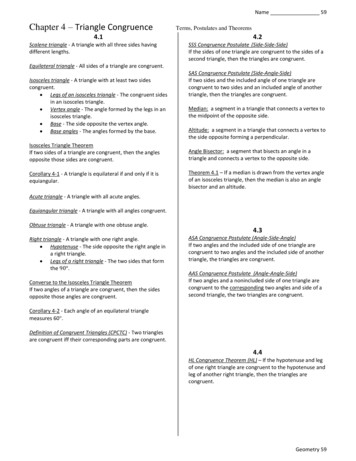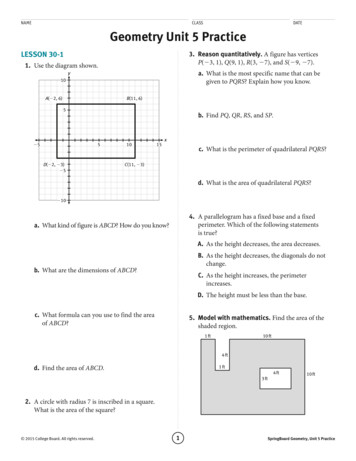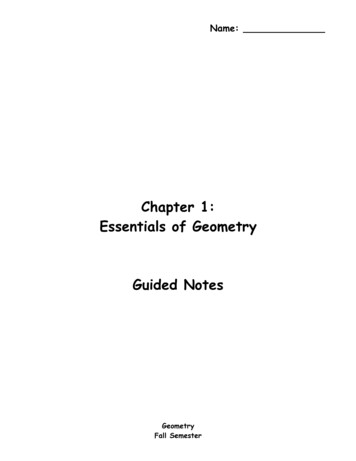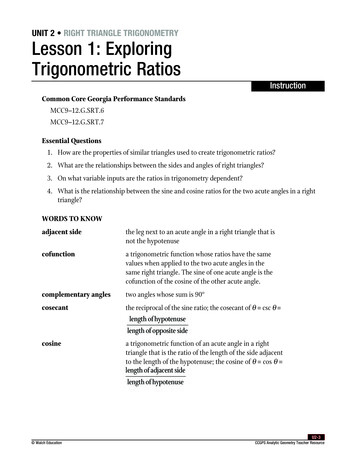
Transcription
6/*5 t RIGHT TRIANGLE TRIGONOMETRYLesson 1: ExploringTrigonometric RatiosInstructionCommon Core Georgia Performance al Questions1. How are the properties of similar triangles used to create trigonometric ratios?2. What are the relationships between the sides and angles of right triangles?3. On what variable inputs are the ratios in trigonometry dependent?4. What is the relationship between the sine and cosine ratios for the two acute angles in a righttriangle?WORDS TO KNOWadjacent sidethe leg next to an acute angle in a right triangle that isnot the hypotenusecofunctiona trigonometric function whose ratios have the samevalues when applied to the two acute angles in thesame right triangle. The sine of one acute angle is thecofunction of the cosine of the other acute angle.complementary anglestwo angles whose sum is 90ºcosecantthe reciprocal of the sine ratio; the cosecant of V csc V length of hypotenuselength of opposite sidecosinea trigonometric function of an acute angle in a righttriangle that is the ratio of the length of the side adjacentto the length of the hypotenuse; the cosine of V cos V length of adjacent sidelength of hypotenuseU2-3 Walch EducationCCGPS Analytic Geometry Teacher Resource
6/*5 t RIGHT TRIANGLE TRIGONOMETRYLesson 1: Exploring Trigonometric RatiosInstructioncotangentthe reciprocal of tangent; the cotangent of V cot V length of adjacent sidelength of opposite sidehypotenusethe side opposite the vertex of the 90º angle in a righttriangleidentityan equation that is true regardless of what values arechosen for the variablesopposite sidethe side across from an anglephi (K)a Greek letter sometimes used to refer to an unknownangle measurethe relation between two quantities; can be expressed inwords, fractions, decimals, or as a percentageratioreciprocala number that, when multiplied by the original number,has a product of 1right trianglea triangle with one angle that measures 90ºscale factora multiple of the lengths of the sides from one figureto the transformed figure. If the scale factor is largerthan 1, then the figure is enlarged. If the scale factor isbetween 0 and 1, then the figure is reduced.secantthe reciprocal of cosine; the secant of V sec V length of hypotenuselength of adjacent sidesimilartwo figures that are the same shape but not necessarilythe same size. Corresponding angles must be congruentand sides must have the same ratio. The symbol forrepresenting similarity is .sinea trigonometric function of an acute angle in a righttriangle that is the ratio of the length of the oppositeside to the length of the hypotenuse; the sine of V sin Vlength of opposite side length of hypotenuseU2-4CCGPS Analytic Geometry Teacher Resource Walch Education
6/*5 t RIGHT TRIANGLE TRIGONOMETRYLesson 1: Exploring Trigonometric RatiosInstructiontangenta trigonometric function of an acute angle in a righttriangle that is the ratio of the length of the oppositeside to the length of the adjacent side; the tangent of V length of opposite sidetan V length of adjacent sidetheta (V)a Greek letter commonly used to refer to unknown anglemeasurestrigonometrythe study of triangles and the relationships betweentheir sides and the angles between these sidesRecommended Resources AJ Design Software. “Triangle Equations Formulas Calculator.”http://www.walch.com/rr/00041This excellent website provides links to interactive calculators that help users solve forthe various attributes of different types of triangles. For the Pythagorean Theorem,users can plug in known values for the legs of a right triangle, and the site will calculatethe length of the hypotenuse. Keisan: High Accuracy Calculation. “Solar elevation angle (for a day).”http://www.walch.com/rr/00042This website features a solar calculator that will return the angle of elevation of the sunfor any time of day at any latitude. The results are shown in a table and a graph. MathIsFun.com. “Sine, Cosine and Tangent.”http://www.walch.com/rr/00043Scroll down to the bottom of this site to find a tool for changing an angle and seeingthe three main ratios of trigonometry change. Teach Engineering. “Hands-on Activity: Stay in Shape.”http://www.walch.com/rr/00044This site provides a real-life example of how the equations in basic geometry andtrigonometry are used in navigation.U2-5 Walch EducationCCGPS Analytic Geometry Teacher Resource
NAME:6/*5 t RIGHT TRIANGLE TRIGONOMETRYLesson 1: Exploring Trigonometric RatiosLesson 2.1.1: Defining Trigonometric RatiosWarm-Up 2.1.1Contractors are repairing and painting the tower on the county courthouse. They need to calculatethe height of the tower to know what equipment they will need. The diagram below shows how theymeasured the height of the tower using a laser light, a post, and a tape measure. They put the post inthe ground 3 feet in front of a 3-foot-tall tripod that has a laser on it. The height of the post is 8 feet,and the post is perpendicular to the ground. The laser is aimed just above the post so that the lightbeam hits the top of the tower. The post is 45 feet from the base of the courthouse tower.5 feet45 feet3 feet3 feet1. How many triangles are shown in the diagram? Draw and label each one.2. Which angle do the triangles share in common?continuedU2-6CCGPS Analytic Geometry Teacher Resource Walch Education
NAME:6/*5 t RIGHT TRIANGLE TRIGONOMETRYLesson 1: Exploring Trigonometric Ratios3. Which angles are congruent?4. Are the triangles similar?5. What is the scale factor, k, of the triangles?6. How can you use the scale factor, k, to find the height, h, of the tower?U2-7 Walch EducationCCGPS Analytic Geometry Teacher Resource
6/*5 t RIGHT TRIANGLE TRIGONOMETRYLesson 1: Exploring Trigonometric RatiosInstructionLesson 2.1.1: Defining Trigonometric RatiosCommon Core Georgia Performance StandardMCC9–12.G.SRT.6Warm-Up 2.1.1 DebriefContractors are repairing and painting the tower on the county courthouse. They need to calculatethe height of the tower to know what equipment they will need. The diagram below shows how theymeasured the height of the tower using a laser light, a post, and a tape measure. They put the post inthe ground 3 feet in front of a 3-foot-tall tripod that has a laser on it. The height of the post is 8 feet,and the post is perpendicular to the ground. The laser is aimed just above the post so that the lightbeam hits the top of the tower. The post is 45 feet from the base of the courthouse tower.5 feet45 feet3 feet3 feet1. How many triangles are shown in the diagram? Draw and label each one.U2-8CCGPS Analytic Geometry Teacher Resource Walch Education
6/*5 t RIGHT TRIANGLE TRIGONOMETRYLesson 1: Exploring Trigonometric RatiosInstructionB’B5 feetA3 feetC45 feetC’There are two triangles in the drawing: -ABC and -ABeC e .2. Which angle do the triangles share in common?The triangles share A .3. Which angles are congruent?Both triangles are right triangles with a 90º angle and a shared angle. Because the triangles havetwo congruent angles, their third angles must also be congruent.4. Are the triangles similar?Yes, the triangles are similar by the Angle-Angle Similarity Statement. ABC ABeC e because they have two congruent angles ( A A and C C ′ ).U2-9 Walch EducationCCGPS Analytic Geometry Teacher Resource
6/*5 t RIGHT TRIANGLE TRIGONOMETRYLesson 1: Exploring Trigonometric RatiosInstruction5. What is the scale factor, k, of the similar triangles?length of image sidelength of preimage sideAC ′AC483 k" 16 scale factorEquation for scale factorDivide the image side by the preimage side.Substitute values and solve.6. How can you use the scale factor, k, to find the height, h, of the tower?Divide the height of the tower (B’C’) by the height of the post (BC ).B′C ′ kBCB′C ′ BC kB′C ′ 5 16 80Add 3 feet to account for the height of the laser tripod.h 80 3 83 feetConnection to the Lesson Students will use the properties of similar triangles to solve real-life problems involving sidelengths. Students will use trigonometry to find unknown angles and lengths in right triangles. Students will learn that the applications of trigonometry can be even more powerful than theuse of similar triangles or the Pythagorean Theorem. Students will discover the ratios found in right triangles.U2-10CCGPS Analytic Geometry Teacher Resource Walch Education
6/*5 t RIGHT TRIANGLE TRIGONOMETRYLesson 1: Exploring Trigonometric RatiosInstructionPrerequisite SkillsThis lesson requires the use of the following skills: measuring angles with a protractorunderstanding how to label angles and sides in trianglesconverting fractions into decimalssolving for one unknown number in a ratio or proportionunderstanding the properties of similar trianglesunderstanding and applying the properties of dilationsusing the Pythagorean Theoremunderstanding how to set up and use ratiosconverting measurement units within the same system (e.g., from inches to feet)IntroductionNavigators and surveyors use the properties of similar right triangles. Designers and builders useright triangles in constructing structures and objects. Cell phones and Global Positioning Systems(GPS) use the mathematical principles of algebra, geometry, and trigonometry. Trigonometry is thestudy of triangles and the relationships between their sides and the angles between these sides. In thislesson, we will learn about the ratios between angles and side lengths in right triangles. A ratio is therelation between two quantities; it can be expressed in words, fractions, decimals, or as a percentage.Key Concepts Two triangles are similar if they have congruent angles. Remember that two figures are similar when they are the same shape but not necessarily thesame size; the symbol for representing similarity is . Recall that the hypotenuse is the side opposite the vertex of the 90º angle in a right triangle.Every right triangle has one 90º angle. If two right triangles each have a second angle that is congruent with the other, the twotriangles are similar. Similar triangles have proportional side lengths. The side lengths are related to each other bya scale factor. Examine the proportional relationships between similar triangles -ABC and -DEF in thediagram that follows. The scale factor is k 2. Notice how the ratios of corresponding sidelengths are the same as the scale factor.U2-11 Walch EducationCCGPS Analytic Geometry Teacher Resource
6/*5 t RIGHT TRIANGLE TRIGONOMETRYLesson 1: Exploring Trigonometric RatiosInstructionProportional Relationships in Similar TrianglesADc 26b 10f 13e 5Ca 24BFd 12Corresponding sidesSide lengthsa b c" "d e f24 10 26" "12 5 13EExamine the three ratios of side lengths in -ABC. Notice how theseratios are equal to the same ratios in -DEF .Corresponding sidesSide lengthsa24 12"26 1310 5"26 1324 12"10 5cbc""dfefa d"b e The ratio of the lengths of two sides of a triangle is the same as the ratio of the correspondingsides of any similar triangle. The three main ratios in a right triangle are the sine, the cosine, and the tangent. These ratiosare based on the side lengths relative to one of the acute angles. The sine of an acute angle in a right triangle is the ratio of the length of the opposite side tolength of opposite sidethe length of the hypotenuse; the sine of V sin V .length of hypotenuseThe cosine of an acute angle in a right triangle is the ratio of the length of the side adjacent tolength of adjacent sidethe length of the hypotenuse; the cosine of V cos V .length of hypotenuse U2-12CCGPS Analytic Geometry Teacher Resource Walch Education
6/*5 t RIGHT TRIANGLE TRIGONOMETRYLesson 1: Exploring Trigonometric RatiosInstruction The tangent of an acute angle in a right triangle is the ratio of the length of the opposite sidelength of opposite sideto the length of the adjacent side; the tangent of V tan V .length of adjacent sideThe acute angle that is being used for the ratio can be called the angle of interest. It iscommonly marked with the symbol V (theta).Theta (V) is a Greek letter commonly used as an unknown angle measure.HypotenuseSide oppositeangle θAngle θSide adjacent to angle θ See the following examples of the ratios for sine, cosine, and tangent.sine of V sin V length of opposite sidelength of hypotenusecosine of V cos V length of adjacent sidelength of hypotenuselength of opposite sidetangent of V tan V length of adjacent ehypotenuseadjacenthypotenuseoppositeadjacent Unknown angle measures can also be written using the Greek letter phi (K). The three main ratios can also be shown as reciprocals. The reciprocal is a number that when multiplied by the original number the product is 1. The reciprocal of sine is cosecant. The reciprocal of cosine is secant, and the reciprocal oftangent is cotangent.cosecant of V csc V secant of V sec V length of hypotenuselength of opposite sidelength of hypotenuselength of adjacent sideU2-13 Walch EducationCCGPS Analytic Geometry Teacher Resource
6/*5 t RIGHT TRIANGLE TRIGONOMETRYLesson 1: Exploring Trigonometric RatiosInstructioncotangent of V cot V length of adjacent sidelength of opposite sideEach acute angle in a right triangle has different ratios of sine, cosine, and tangent. The length of the hypotenuse remains the same, but the sides that are opposite or adjacent foreach acute angle will be different for different angles of interest. The two rays of each acute angle in a right triangle are made up of a leg and the hypotenuse.The leg is called the adjacent side to the angle. Adjacent means “next to.” In a right triangle, the side of the triangle opposite the angle of interest is called the oppositeside. Calculations in trigonometry will vary due to the variations that come from measuring anglesand distances. A final calculation in trigonometry is frequently expressed as a decimal. A calculation can be made more accurate by including more decimal places. The context of the problem will determine the number of decimals places to which to round.Examples: A surveyor usually measures tracts of land to the nearest tenth of a foot. A computer manufacturer needs to measure a microchip component to a size smallerthan an atom. A carpenter often measures angles in whole degrees. An astronomer measures angles to13600of a degree or smaller.Common Errors/Misconceptions confusing the differences between the trigonometric ratios forgetting to change the adjacent and opposite sides when working with the two acuteangles mistakenly trying to use sine, cosine, and tangent ratios for triangles that are not righttriangles mistakenly thinking that trigonometry will always find the exact length of a side or theexact measure of an angleU2-14CCGPS Analytic Geometry Teacher Resource Walch Education
6/*5 t RIGHT TRIANGLE TRIGONOMETRYLesson 1: Exploring Trigonometric RatiosInstructionGuided Practice 2.1.1Example 1Find the sine, cosine, and tangent ratios for A and B in -ABC . Convert the ratios to decimalequivalents.Acb 3Ca 4B1. Find the length of the hypotenuse using the Pythagorean Theorem.a2 b2 c2Pythagorean Theorem42 32 c2Substitute values for a and b.16 9 c2Simplify.25 c2 25 c 2c t 5Since c is a length, use the positive value, c 5.U2-15 Walch EducationCCGPS Analytic Geometry Teacher Resource
6/*5 t RIGHT TRIANGLE TRIGONOMETRYLesson 1: Exploring Trigonometric RatiosInstruction2. Find the sine, cosine, and tangent of A .Set up the ratios using the lengths of the sides and hypotenuse, thenconvert to decimal form.opposite4" " 0.8hypotenuse 5adjacent3cos A " " 0.6hypotenuse 5sin A tan A opposite 4" " 1.333adjacent 33. Find the sine, cosine, and tangent of B .Set up the ratios using the lengths of the sides and the hypotenuse,and then convert to decimal form.sin B "opposite3" " 0.6hypotenuse 5cos B "adjacent4" " 0.8hypotenuse 5tan B "opposite 3" " 0.75adjacent 4U2-16CCGPS Analytic Geometry Teacher Resource Walch Education
6/*5 t RIGHT TRIANGLE TRIGONOMETRYLesson 1: Exploring Trigonometric RatiosInstructionExample 2Given the triangle below, set up the three trigonometric ratios of sine, cosine, and tangent for theangle given. Compare these ratios to the trigonometric functions using your calculator.A53.1 c 10b 6Ca 8B1. Set up the ratios for sin A, cos A, and tan A and calculate the decimalequivalents.sin 53.1º "cos 53.1º "8106" 0.8" 0.6108tan 53.1º " " 1.3336U2-17 Walch EducationCCGPS Analytic Geometry Teacher Resource
6/*5 t RIGHT TRIANGLE TRIGONOMETRYLesson 1: Exploring Trigonometric RatiosInstruction2. Use your graphing calculator to find sin 53.1º.On a TI-83/84:First, make sure your calculator is in Degree mode.Step 1: Press [MODE].Step 2: Arrow down to RADIAN.Step 3: Arrow over to DEGREE.Step 4: Press [ENTER]. The word DEGREE should be highlightedinside a black rectangle.Step 5: Press [2ND].Step 6: Press [MODE] to QUIT.Important: You will not have to change to Degree mode again unlessyou have changed your calculator to Radian mode.Now you can find the value of sin 53.1º:Step 1: Press [SIN].Step 2: Enter the angle measurement: 53.1.Step 3: Press [ ) ].Step 4: Press [ENTER].On a TI-Nspire:First, make sure the calculator is in Degree mode.Step 1: From the home screen, select 5: Settings & Status, then 2:Settings, then 2: Graphs & Geometry.Step 2: Press [tab] twice to move to the Geometry Angle field, andthen select Degree from the drop-down menu.Step 3: Press [tab] to move to the “OK” option and select it usingthe center button on the navigation pad.Next, calculate the sine of 53.1º.Step 1: From the home screen, select a new Calculate window.Step 2: Press [trig] to bring up the menu of trigonometric functions.Use the keypad to select “sin,” then type 53.1 and press[enter].sin 53.1º 0.7996846585U2-18CCGPS Analytic Geometry Teacher Resource Walch Education
6/*5 t RIGHT TRIANGLE TRIGONOMETRYLesson 1: Exploring Trigonometric RatiosInstruction3. Use your graphing calculator to find cos 53.1º.On a TI-83/84:Step 1: Press [COS].Step 2: Enter the angle measurement: 53.1.Step 3: Press [ ) ].Step 4: Press [ENTER].On a TI-Nspire:Step 1: From the home screen, select a new Calculate window.Step 2: Press [trig] to bring up the menu of trigonometric functions.Use the keypad to select “cos,” then type 53.1 and press[enter].cos 53.1º 0.60042022534. Use your graphing calculator to find tan 53.1º.On a TI-83/84:Step 1: Press [TAN].Step 2: Enter the angle measurement: 53.1.Step 3: Press [ ) ].Step 4: Press [ENTER].On a TI-Nspire:Step 1: From the home screen, select a new Calculate window.Step 2: Press [trig] to bring up the menu of trigonometric functions.Use the keypad to select “tan,” then type 53.1 and press[enter].tan 53.1º 1.3318749525. Compare the calculator values to the ratios. Explain the difference.The values are very close to the ratios of the side lengths.The differences are due to the angle measurement of53.1º being an approximation.U2-19 Walch EducationCCGPS Analytic Geometry Teacher Resource
6/*5 t RIGHT TRIANGLE TRIGONOMETRYLesson 1: Exploring Trigonometric RatiosInstructionExample 3A right triangle has a hypotenuse of 5 and a side length of 2. Find the angle measurements and theunknown side length. Find the sine, cosine, and tangent for both angles. Without drawing anothertriangle, compare the trigonometric ratios of -ABC with those of a triangle that has been dilated bya factor of k 3.1. First, draw the triangle with a ruler, and label the side lengths andangles.Ac 5 cmb 2 cmCa ? cmB2. Find a by using the Pythagorean Theorem.a2 b 2 c 2Pythagorean Theorema2 22 52Substitute values for b and c.a2 4 25Simplify.a2 21a 4.5826 centimetersU2-20CCGPS Analytic Geometry Teacher Resource Walch Education
6/*5 t RIGHT TRIANGLE TRIGONOMETRYLesson 1: Exploring Trigonometric RatiosInstruction3. Use a protractor to measure one of the acute angles, and then use thatmeasurement to find the other acute angle.m A 66.5We know that m C 90 by the definition of right angles.The measures of the angles of a triangle sum to 180.Subtract m A and m C from 180 to find m B .m B 180 m A m Cm B 180 (66.5) (90)m B 180 156.5m B 23.54. Find the sine, cosine, and tangent ratios for both acute angles. Expressyour answer in decimal form to the nearest thousandth. Asin 66.5º 4.58265 B 0.9162cos 66.5º 0.45tan66.5º 4.58262 2.2912sin 23.5º 0.45cos 23.5º 4.5826tan 23.5º 254.5826 0.916 0.436U2-21 Walch EducationCCGPS Analytic Geometry Teacher Resource
6/*5 t RIGHT TRIANGLE TRIGONOMETRYLesson 1: Exploring Trigonometric RatiosInstruction5. Without drawing a triangle, find the sine, cosine, and tangentfor a triangle that has a scale factor of 3 to -ABC . Compare thetrigonometric ratios for the two triangles.Multiply each side length (a, b, and c) by 3 to find a', b', and c'.ae 3 a 3 (4.5826) 13.7478be 3 b 3 (2) 6ce 3 c 3 (5) 15Set up the ratios using the side lengths of the dilated triangle.sin 66.5º 13.7478cos 66.5º 6tan 66.5º 1515 0.916 0.413.74786 2.291sin 23.5º 615 0.4cos 23.5º 13.7478tan 23.5º 61513.7478 0.916 0.436The sine, cosine, and tangent do not change in the largertriangle. Similar triangles have identical side length ratiosand, therefore, identical trigonometric ratios.U2-22CCGPS Analytic Geometry Teacher Resource Walch Education
6/*5 t RIGHT TRIANGLE TRIGONOMETRYLesson 1: Exploring Trigonometric RatiosInstructionExample 4What are the secant (sec), cosecant (csc), and cotangent (cot) ratios for an isosceles right triangle?1. An isosceles right triangle has two angles that measure 45º. The twoside lengths have equal lengths of 1 unit.2. Use the Pythagorean Theorem to find the hypotenuse.12 12 c 21 1 c22 c22 c3. Substitute the side lengths into the ratios.csc 45º sec 45º cot 45º "hypotenuseoppositehypotenuseadjacent 2121 1.414 1.414adjacent 1" "1opposite 1U2-23 Walch EducationCCGPS Analytic Geometry Teacher Resource
6/*5 t RIGHT TRIANGLE TRIGONOMETRYLesson 1: Exploring Trigonometric RatiosInstructionExample 5Triangle ABC is a right triangle where m A 40º and side a 10 centimeters. What is the sine of A ? Check your work with the sin function on your graphing calculator.1. Draw -ABC with a ruler and protractor.A40 cbCa 10 cmB2. Measure the length of hypotenuse c.c 15.6 centimetersSubstitute the side lengths into the ratios to determine the sine of A .sin40º 1015.6 0.6413. Use your calculator to check the answer.Follow the steps outlined in Example 2.sin 40º 0.6427876097The two answers are fairly close. The difference is due tothe imprecise nature of manually drawing andmeasuring a triangle.U2-24CCGPS Analytic Geometry Teacher Resource Walch Education
NAME:6/*5 t RIGHT TRIANGLE TRIGONOMETRYLesson 1: Exploring Trigonometric RatiosProblem-Based Task 2.1.1: Building a Porch RampBill’s father is building a ramp to reach the front porch of their house. The ramp will rise from theflat ground to the top of the porch. The porch is 2 feet tall. The ramp will rise at a 10º angle from theground. How long does the ramp need to be? What is the sine of 10º?U2-25 Walch EducationCCGPS Analytic Geometry Teacher Resource
NAME:6/*5 t RIGHT TRIANGLE TRIGONOMETRYLesson 1: Exploring Trigonometric RatiosProblem-Based Task 2.1.1: Building a Porch RampCoachinga. Create a drawing of the problem.b. Is there a triangle in this problem?c. Do you have enough information to draw a similar triangle to the drawing?d. Can you make a precise drawing to scale that shows the known length and angles?e. Is your small triangle similar to the large scale of the ramp?f. What is the scale factor between the height of the porch in your drawing and the porch’sactual height?g. Which length in your drawing corresponds to the ramp length?h. How do you use the length in the drawing and the scale factor to find the length of the ramp?i. What is the ratio for the sine of 10º?U2-26CCGPS Analytic Geometry Teacher Resource Walch Education
6/*5 t RIGHT TRIANGLE TRIGONOMETRYLesson 1: Exploring Trigonometric RatiosInstructionProblem-Based Task 2.1.1: Building a Porch RampCoaching Sample Responsesa. Create a drawing of the problem.PorchRamp2 feet10 b. Is there a triangle in this problem?Yes; the triangle is formed by the ramp (the hypotenuse), the height of the porch, and the flatground.c. Do you have enough information to draw a similar triangle?Yes. There is information for two angles: an angle of 10º is given, and the angle the groundmakes with the porch is 90º. This means you can draw a similar triangle to the triangle createdby the ramp. The third angle is 90º 10º 80º.d. Can you make a precise drawing to scale that shows the known length and angle?Yes. You can use a protractor to create a 10º angle and a 90º angle, and a ruler to draw a sidelength that corresponds in units to the porch height (suggested scale: 1/2 inch 1 foot). Scalefactors of 1 inch : 1 foot will require paper that is at least 12 inches long.e. Is your small triangle similar to the large scale of the ramp?Yes. This is a scaled drawing that includes the 10º angle, the 90º angle, and the height of theporch.f. What is the scale factor between the height of the porch in your drawing and the porch’s actualheight?The scale factor will vary depending on how large the triangle is in the drawing. If students usethe ratio 1/2 : 1, the scale factor is 1 : 24, making k 24.g. Which length in your drawing corresponds to the ramp length?The length is the hypotenuse on the drawing.U2-27 Walch EducationCCGPS Analytic Geometry Teacher Resource
6/*5 t RIGHT TRIANGLE TRIGONOMETRYLesson 1: Exploring Trigonometric RatiosInstructionh. How do you use the length in the drawing and the scale factor to find the length of the ramp?Multiply the length of the hypotenuse by the scale factor.First, measure the hypotenuse. If the scale on the drawing is 1/2 : 1, the length of the ramp inthe drawing would equal approximately 5.75 inches.Multiply the length of the drawn ramp by the scale factor to determine the length of the actualramp.5.75 24 138 inches 11.5 feetCompare students’ answers and see the variation in measurement data. Almost all the answersshould range from 10.75 feet to 12.25 feet.i. What is the sine of 10º?2sin 10º 11.5 0.174Recommended Closure ActivitySelect one or more of the essential questions for a class discussion or as a journal entry prompt.U2-28CCGPS Analytic Geometry Teacher Resource Walch Education
NAME:6/*5 t RIGHT TRIANGLE TRIGONOMETRYLesson 1: Exploring Trigonometric RatiosPractice 2.1.1: Defining Trigonometric RatiosUse -ABC to complete problems 1–4. Round your answers to the nearest thousandths.A4 cmC5.71 cmB1. Set up and calculate the trigonometric ratios for the sine, cosine, and tangent of A .2. Set up and calculate the trigonometric ratios for the cosecant, secant, and cotangent of A .3. Set up and calculate the trigonometric ratios for the sine, cosine, and tangent of B .4. Set up and calculate the trigonometric ratios for the cosecant, secant, and cotangent of B .continuedU2-29 Walch EducationCCGPS Analytic Geometry Teacher Resource
NAME:6/*5 t RIGHT TRIANGLE TRIGONOMETRYLesson 1: Exploring Trigonometric RatiosDraw triangles using the given information to complete problems 5 and 6.5. A right triangle has side lengths of a 8 and b 4. Find the angle measurements and the lengthof the hypotenuse. Then, find the sine, cosine, and tangent for angles A and B (across from sidesa and b respectively).6. A right triangle has a side length of a 4 and a hypotenuse of 8. Find the angle measurementsof A and B. Then, find the sine, cosine, and tangent for both acute angles.Use the given information to complete problems 7–10.7. A carpenter needs to measure the length of the beams that will support a roof. The building is50 feet wide. The roof will rise at an angle of 30º from the top of the walls. The peak of the roofis 14.43 feet above the top of the walls. The side adjacent to the 30º angle is half the width ofthe building. How long is each supporting beam, b, to the nearest thousandth? Add 2 feet to thebeam length so that the roof can extend 2 feet past the walls. What is the cosine of 30º?Beam (b)14.43 feet30 Building width 50 feetcontinuedU2-30CCGPS Analytic Geometry Teacher Resource Walch Education
NAME:6/*5 t RIGHT TRIANGLE TRIGONOMETRYLesson 1: Exploring Trigonometric Ratios8. A water park has a straight slide into a deep pool. The slide is 50 feet long. It rises from thepool at an angle of 45º. How tall do the vertical supports of the platform need to be to supportthe platform at the top of the slide? The bottom of the slide is 35.355 feet from the verticalsupports. What is the sine of 45º? Round to the nearest thousandth.Slide 50 feetLadder45OPoolcontinuedU2-31 Walch EducationCCGPS Analytic Geometry Teacher Resource
NAME:6/*5 t RIGHT TRIANGLE TRIGONOMETRYLesson 1: Exploring Trigonometric Ratios9. Students are having a contest to see who can find the tallest tree in a park. To win, a studentmust measure the height of the tree without climbing the tree. Martha locates a very tall oaktree. She measures that the tree’s shadow is 45 feet long. Martha has a shadow that is 11.5 feetlong. She is 5.75 feet tall. How tall is the oak tree? What is the tangent of A ?Rays of sunAOak tree shadow 45 feetRays of sunHeight 5.75 feetShadow 11.5 feetcontinuedU2-32CCGPS Analytic Geometry Teacher Resource Walch Education
NAME:6/*5 t RIGHT TRIANGLE TRIGONOMETRYLesson 1: Exploring Trigonometric Ratios10. The drawing below shows a ladder against a wall. How high on the wall does the ladder reach ifthe ladder is 14.62 feet long? Use your answer to find the sine of B.A20 bCca 5 feetBU2-33 W
(GPS) use the mathematical principles of algebra, geometry, and trigonometry. Trigonometry is the study of triangles and the relationships between their sides and the angles between these sides. In this lesson, we will learn about the ratios between angles and side lengths in right triangles. A ratio is the


